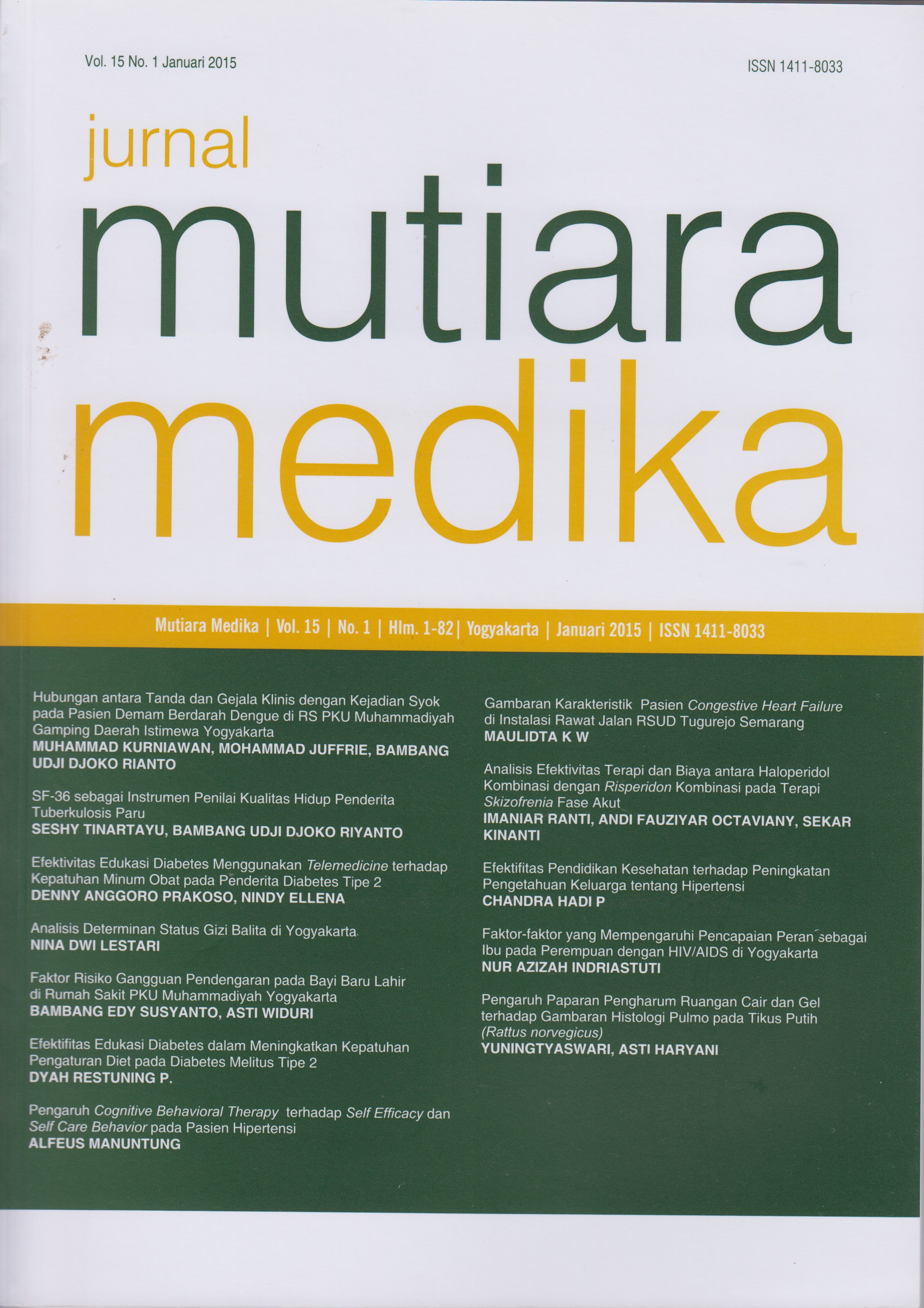SF-36 sebagai Instrumen Penilai Kualitas Hidup Penderita Tuberkulosis (TB) Paru
DOI:
https://doi.org/10.18196/mmjkk.v15i1.2488Keywords:
SF-36, Quality of Life, pulmonary tuberculosis, Kualitas Hidup, TB paruAbstract
Short Form-36 (SF-36) merupakan instrumen baku untuk menilai kualitas hidup kasus penyakit kronis. Tuberkulosis (TB) merupakan penyakit kronis yang masih menjadi masalah kesehatan dunia karena merupakan salah satu penyebab mortalitas dan morbiditas dengan kematian berkisar 1 juta jiwa setiap tahunnya dan Indonesia ranking kelima negara dengan beban TB tertinggi di dunia (WHO, 2009). Penggunaan SF-36 pada kasus tuberkulosis belum banyak dilakukan. Tujuan penelitian ini adalah mengetahui kesesuaian SF-36 sebagai penilai kualitas hidup penderita tuberkulosis (TB) paru. Metode penelitian deskriptif analitik. Data diperoleh dari hasil wawancara langsung pada penderita TB paru. Hasil penelitian menunjukkan 54 orang penderita TB paru terbanyak laki-laki (53,7%), kelompok umur terbanyak usia produktif 16-29 tahun (46,3%). Mayoritas pendidikan menengah kebawah, 72,2% tidak bekerja, dan status gizi mayoritas kurang. Rerata nilai total kualitas hidup pada awal dan setelah terapi fase intensif mengalami peningkatan (43,58 menjadi 76,76). Hasil perhitungan statistik diperoleh nilai p disemua dimensi SF-36 adalah 0,001 sehingga p < 0,05, artinya terdapat perbedaan kualitas hidup pasien TB paru pada awal dengan akhir terapi OAT fase intensif. Kesimpulan penelitian adalah SF-36 dapat digunakan sebagai instrumen penilai kualitas hidup pasien tuberkulosis (TB) paru.Short Form-36 (SF-36) is a standard instrument for assessing quality of life of chronic disease cases. Tuberculosis (TB) is a chronic disease and Indonesia has fifth rank with the highest TB burden in the world (WHO, 2009). Use of SF-36 in the case of tuberculosis has not been done. The purpose of this study was to determine the suitability of the SF-36 quality of life as assessor for tuberculosis. Descriptive analytic method. Data obtained from interviews directly in pulmonary tuberculosis patients. The results showed 54 patients most of them are men (53.7%), the largest age group of productive age of 16-29 years and having middle education, did not work, the nutritional status of the majority less. The mean value of the total quality of life at baseline and after the intensive phase of treatment has increased. Statistical calculation results obtained by value p in all dimensions of the SF-36 is 0,001, there is a difference in the quality of life of patients with pulmonary tuberculosis at the beginning of the end of the intensive phase of treatment. Conclusion of the study is the SF-36 can be used as an instrument appraiser quality of life of patients of tuberculosis.
References
WHO. Treatment of Tuberculosis Guidelines. Edisi 4. Geneva: World Health Organization. 2009.
Kementerian Kesehatan RI. Profil Kesehatan Jawa Barat. 2012. www.depkes.go.id
Kementerian Kesehatan RI. Ringkasan Eksekutif Data dan Informasi Kesehatan Provinsi Jawa Barat. 2013. www.depkes.go.id
Guo Na, Marra Fawziah, Marra Carlo. Measuring Health-Related Quality of Life in Tuberculosis: A Systematic Review. Health qulity of life outcomes. Biomed central. 2009.
Rajeswari R., Muniyandi M., Balasubramanian., Narayanan P.R. Perceptions of Tuberculosis Patients about Their Physical, Mental and Social Well-Being: a Field Report from South India. Social Science & Medicine, 2005; 60: 1845-1853.
Robert, S. Faktor-faktor yang Berhubungan dengan Kualitas Hidup Penderita Penyakit Parkinson di Poliklinik Saraf RS dr Kariadi. Tesis, Semarang: Program Pascasarjana Magister Ilmu Biomedik dan Program Pendidikan Dokter Spesialis Ilmu Penyakit Saraf UNDIP. 2007.
WHO. WHOQOL Measuring Quality of Life. Programme on Mental Health. Division of Mental Health and Prevention of Substance Abuse, Word Health Organization. 1997.
Ware, J. SF-36 Health Survey (Version 1.0) for use in Australia. Australian Health Outcomes Collaboration (AHOC). University of Wallongong. 2005.
Marra A.C., Marra F., Cox V., Palepu A., Fitzgerald J. Factors Influencing Quality of Life in Patients with Active Tuberculosis. Health and Quality Life Outcome. Biomed central. 2004: 1-10
Abhishek, B. & Smita, S. Study of Impact of Antitubercular Therapy on Quality of Life. Indian J Med Scie, 2013; 66 (3 and 4).
Downloads
Issue
Section
License
Copyright
Authors retain copyright and grant Mutiara Medika: Jurnal Kedokteran dan Kesehatan (MMJKK) the right of first publication with the work simultaneously licensed under an Attribution 4.0 International (CC BY 4.0) that allows others to remix, adapt and build upon the work with an acknowledgment of the work's authorship and of the initial publication in Mutiara Medika: Jurnal Kedokteran dan Kesehatan (MMJKK).
Authors are permitted to copy and redistribute the journal's published version of the work (e.g., post it to an institutional repository or publish it in a book), with an acknowledgment of its initial publication in Mutiara Medika: Jurnal Kedokteran dan Kesehatan (MMJKK).
License
Articles published in the Mutiara Medika: Jurnal Kedokteran dan Kesehatan (MMJKK) are licensed under an Attribution 4.0 International (CC BY 4.0) license. You are free to:
- Share — copy and redistribute the material in any medium or format.
- Adapt — remix, transform, and build upon the material for any purpose, even commercially.
This license is acceptable for Free Cultural Works. The licensor cannot revoke these freedoms as long as you follow the license terms. Under the following terms:
Attribution — You must give appropriate credit, provide a link to the license, and indicate if changes were made. You may do so in any reasonable manner, but not in any way that suggests the licensor endorses you or your use.
- No additional restrictions — You may not apply legal terms or technological measures that legally restrict others from doing anything the license permits.






